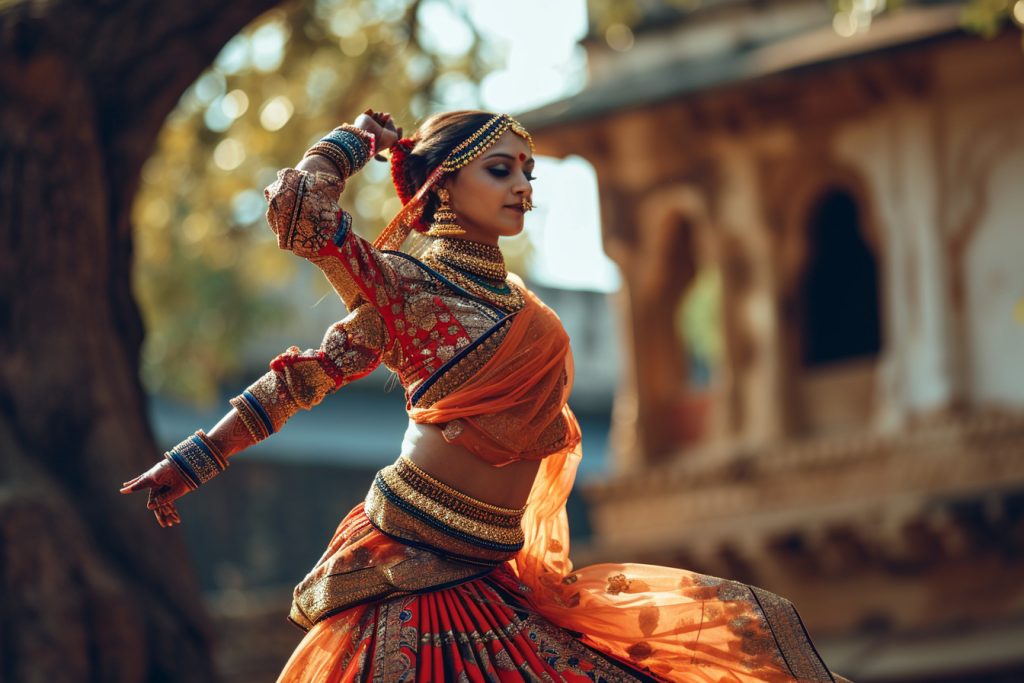India, a land of swirling colors, vibrant rituals, and profound expressions, is also home to an astonishing array of dance forms that are not just art but also a testament to the country’s rich cultural tapestry. Each corner of this sprawling subcontinent echoes with the sound of ghungroos (ankle bells) and dhol beats, inviting us to dive deep into a dance heritage that has been shaped and nurtured over thousands of years. As we embark on this enchanting journey through India’s dance landscape, we’ll discover the depth and diversity of its performing arts. From the intricate footwork of classical dances to the high-energy moves of folk traditions, India’s dances are an expression of life itself.
Step into the Rhythm: Exploring India
India’s dance heritage is a mirror to its diverse nature, embedding within itself a multitude of expressions, styles, and narratives. Stepping into the rhythm of this country is akin to traversing a living, breathing museum of dance that spans from the traditional to the contemporary. In every corner of the nation, from the bustling cities to the serene countryside, dance serves as both a celebration and a sanctum of cultural identity. Whether it’s through the graceful gestures of a classical recital or through the vibrant energy of a village dance, the country constantly keeps its historical heartbeat alive.
The rhythm of India is not just a series of movements; it’s a language that communicates the stories of its people, their emotions, and their deep-rooted beliefs. Exploring this rhythm, one can witness the reflection of the nation’s vast history, its mythologies, and its social milieu. Each dance form is like a chapter of this grand narrative, each style a unique dialect. Dancing in India isn’t merely about following beats; it’s about stepping into a lineage that has been kept alive through centuries of passion, dedication, and innovation.
From Bharatanatyam to Bhangra: The Variety
As we waltz through the archives of India’s dance heritage, Bharatanatyam undoubtedly demands a bow with its disciplined, divine movements and expressive storytelling. Originating in the temples of Tamil Nadu, this classical dance form is an ode to the ancient texts of Natya Shastra and is often performed solo. On the other end of the spectrum, we have Bhangra, a robust and jubilant dance from Punjab, which traditionally celebrates the harvest and is now synonymous with the festive spirit of Sikhs and Punjabis worldwide.
The variety, however, doesn’t stop at these iconic dance forms. From the warrior dance of Chhau, which blends martial arts with rhythmic movements, hailing from Eastern India, to the romantic allure of Kathak that narrates tales through intricate footwork and spins, India’s dance diversity is truly infinite. Kathakali from Kerala, known for its elaborate costumes and makeup, showcases epic stories from Mahabharata and Ramayana, while Manipuri delicately encapsulates the lyrical essence of Radha and Krishna’s love. Each dance form in India is not just a different set of steps or costumes, but a distinct vision of life, a disparate philosophy embodied in movement.
Groove with Tradition: Dance Forms Unveiled
Diving further into the groove of tradition, one uncovers the lesser-known but equally captivating dance forms like Kuchipudi of Andhra Pradesh, which combines fast rhythms with fluid movements, or Mohiniyattam, the dance of the enchantress, celebrated for its feminine grace and poise. Even the tribal and folk dances, such as Giddha of Punjab or Ghoomar of Rajasthan, unveil the raw beauty of India’s cultural canvas, projecting the joy, sorrows, and everyday life of the community it represents.
The beauty of these dance forms lies in their ability to evolve while preserving their core. As they unveil their tales through performances, these dances do not remain confined to the rigid frameworks of tradition. Contemporary interpretations and fusion styles have emerged, breathing new life into the ancient forms, making them relevant to the modern context while ensuring that the essence of India’s dance heritage continues to flourish and inspire. Whether it’s in the disciplined classroom of a dance school or amidst the unrestrained joy of a festival, every Indian dance form offers a unique avenue to connect with the past and groove with the wisdom of generations.
India’s dance heritage is a living, thriving testament to the diverse yet unified spirit of this vast land. As we take our final bow in this exploration, it’s evident that the country’s dances are much more than just an artistic endeavor; they are the rhythmic journal of a civilization. From the classical grandeur of Bharatanatyam to the high-spirited bounces of Bhangra, every step, twirl, and expression is imbued with the history, mythology, and soul of India. As we step out of this rhythmical odyssey, we carry with us the echoes of ghungroos and the colors of India’s dance fabric, reminding us of the enduring legacy that continues to capture the imagination and hearts of people across the globe.









